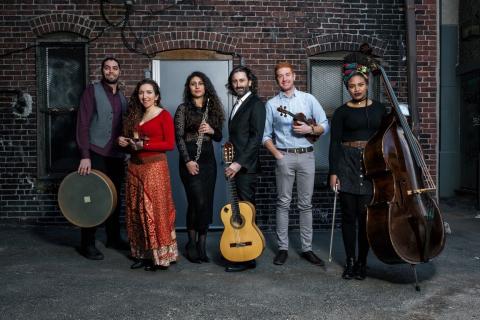The Music
Under the direction of Javier Limón, MMI artistic director, several groups of Berklee students and recent graduates—many from war-torn countries—recorded four discs of music in Boston. Read Limón's essays below about each of the four music packages.
From left: Gilbert Mansour, Tania Mesa, Elif Cakmut, Javier Limón, Layth Al-Rubaye, and Tonina Saputo. Mike Spencer
Disc One | Aegean Sea
The value of the Mediterranean as an artistic hub remains more relevant than ever. Cultures bordering these waters have been the source of some of the most influential musical languages in history (from the Greeks to the Andalusian repertoire); the melodies, rhythms, and sounds of these peoples have laid the foundation of modern music. The younger generations of Mediterranean musicians now mark a stage in all strata of art. A range of sounds—including Arab strings, Celtic harp, flutes, metals from the streets of some Sicilian small town, and Turkish and North African percussion—come together to create an album that possesses diversity, contemporary energy, and a bold, live sound. The leaders of the groups on this recording are young people who have or are studying at Berklee, where they have led and expanded the concept of the Mediterranean musician. They've also performed at major jazz festivals and demonstrated a new way to see the world through their instruments. Hailing from Iraq, Palestine, Israel, Jordan and other places, these players approach these new compositions as their own, resulting in a sound that's both cutting-edge and rooted in tradition. It is important to note the personality in the voice of Tonina Saputo, a young woman who grew up in St. Louis, Missouri, in a multicultural family with ancestry in Uganda and Italy. Her family background is what the essence of what Refugio del Sonido symbolizes. It's all about human movement as the genesis of great musical developments. It's through this work of people for whom borders and prejudices no longer exist that the future of art is created.
Disc Two | Adriatic Sea
On this album we explore the strongest musical language of the 20th century—jazz—in tandem with Mediterranean melodies. The links between the two stories and musical adventures are endless. Since its inception, jazz has been greatly influenced by not only European classical music but by several traditional styles, including Sicilian, French, Baltic, North African, and, of course, Middle Eastern music. These traditions have arrived, one way or another, in the hands of master composers and interpreters of the great genre. In this disc, young jazz musicians used this opportunity to create improvisations with jazz language, vocabulary, and melodies, all while retaining a sound in step with global music traditions and the sound of Refugio.
Disc Three | Libyan Sea
The borders of the Mediterranean are like lines drawn in constant motion. For centuries, the territories frequently changed hands and names while people moved from one place to another. This constant change of name, status, and ways of coexisting have created abundant overlap between today's Mediterranean musical styles. Those commonalities increase with geographical proximity, merging regional sounds when they meet at the edges. Similarly, our Iberian music thrives with richness and diversity, thanks to the languages, rhythms, and styles sharing common roots. Jews, Arabs, Christians, and Gypsies have coexisted for almost 1,000 years, making the musical undercurrents, like the people, all feel like members of the same family. Flamenco is another example, the perfect synthesis and ideal balance of four powerful cultures whose differences and similarities remain—now more than ever—one of the keys to understanding our society. Any Mediterranean or Latin musician feels touched in the soul when listening to flamenco. It is wonderful how the same melody, phrase, or even a single note can sound so different when interpreted by different people. Flamenco, along with all other Iberian traditional music, is the umbilical cord musically uniting us with our multiple origins.
Disc Four | Ionian Sea
Most musicians—whether instrumentalists, singers, or composers—come to Berklee wanting to play compositions of Anglo-Saxon origin. They come with the idea of being a great rock or blues vocalist, to play jazz with incredible musicianship, or to record chart-topping hip-hop tracks. Some achieve those goals, but many begin an interesting process; after some time, particularly time spent away from their homelands, they begin a process of moving away from these newer genres and returning to their cultural roots. In a natural way, Agentinians remember their tango, Brazilians their bossa, Cubans their rhumba, Andalusians their flamenco. All value their roots because it is an important part of what they can contribute to the common good, what makes them different, and it demonstrates how their artistry attracts interest from a world of listeners. Striking a balance between musical evolution and staying in touch with homeland traditions is an accomplishment that only a few masters have achieved, but it's an important and valuable path to follow. In this recording, musicians of Latin American origin build bridges that unite the Americas with the Mediterranean and that create a fluid and beautiful musical communication between both sides of the ocean. It's as if the great Atlantic is narrower than the Mediterranean Sea, and that Buenos Aires and Huelva are closer than Sicily and Tunisia.
